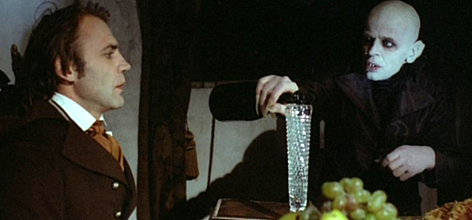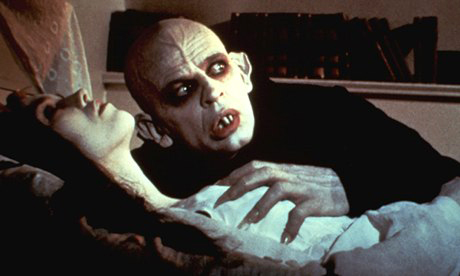|
|
Reviewed by Glenn Erickson
A couple of months back Kino Classics favored disc collectors with a new Blu-ray of the original 1922 Nosferatu, a Symphony of Horror. Now Scream Factory has come up with a Blu-ray of Werner Herzog's accomplished 1979 Klaus Kinski remake, which remarkably enough is a very good movie in its own right. Two language versions are included, the German-voiced Nosferatu Phantom der Nacht and the parallel American version Nosferatu the Vampyre.

Herzog shoots in color but retains the feel of a tale wrapped in cobwebs. Hues are bluish except for the vampire's bulbous head, which has the pale bulbous look of an albino spider. The plot follows the general outline of F.W. Murnau's amazing horror classic, choosing carefully what aspects of the story to accentuate.
Bad news is coming to the port town of Wismar. The eccentric real estate agent Renfield (Roland Topor) is already under the telepathic influence of his distant client Graf Dracula (Klaus Kinski). Renfield sends his salesman Jonathan Harker (Bruno Ganz) across Europe to close a deal. In Transylvania Harker finds the locals so superstitious that the last leg of his journey must be made on foot. In the eerie castle, the cadaverous Graf goes both for the property offered, and Harker's wife Lucy (Isabelle Adjani), whose cameo he admires on Harker's locket. Lucy intuits her husband's danger and by some mysterious telepathy, communicates her love across the miles ... signals that the ghoulish Dracula senses while in the process of vampirizing Harker. Dracula departs for Wismar with a wagonload of earth-filled coffins, eventually travelling as cargo on a sailing ship. Harker manages to escape the locked castle and make his way back home, but not in time. The vampire king kills all aboard the ship, which drifts unmanned into the harbor. A horde of rats swarms from below decks and into the town, carrying the plague. Sick and disoriented, Jonathan makes it home, but is unable to help Lucy cope with the threat of the undead. Reading about vampires in a book, the good wife Lucy resolves to use her body as a sacrifice to destroy the monster, in the only way he can be destroyed.
Werner Herzog must have taken a good look at his actor friend/fiend Klaus Kinski and thought, "now here's a talent born to play a disgusting insect-like ghoul." The good news is that Herzog hasn't just copied the Murnau original. The 1979 movie doesn't play like a mere remake or an update in the style of The New German Cinema. F.W. Murnau used a number of stylized cinematic tricks to conjure an uncanny mood. The use of exaggerated shadows is the obvious one, but the 1922 film also uses fast-motion filming and inverted negative printing to create its effects. Herzog goes for the same kinds of effects, without employing modern opticals and without altering the original's claustrophobic, funereal atmosphere.

Herzog's slow pace and matter-of-fact period detail, along with his usual naturalistic ease with movie stars and non-actors, lulls one into an acceptance of the 'uncanny' content without it seeming ludicrous. As Lucy, Isabelle Adjani is the acting standout, spending at least half of her screen time in wide-eyed horror at sights seen and unseen. Cocooned in an elaborate makeup job, Klaus Kinski compensates for his well-fed looks by appearing more disgusting than old Max Schreck -- it looks as though his bald scalp is a bulging bag containing a brain but no skull. Together these two actors give the remake its best new dimension, an enlarging of the original's psychic bond between the vampire and the loyal housefrau. Kinski's pathetic plea for 'some of the love you give your husband' make the monster more than a bloodsucker, and Adjani's fatal embrace reminds us of the alternate, 'female predator' connotation given the word Vampire.
Herzog moves the camera very little. He tends to keep his master shots a bit wide, to further emulate the boxy feel of most silent pictures. He also allows the pace to be slow. Lucy wanders on a foggy beach while Jonathan putters around Dracula's castle, looking for an escape route. The tidy little town invaded by Nosferatu's horror may be the same location seen in the original fifty years before, as some of the buildings look identical. The director's restaging of a few of Murnau's famous shots shows no lessening of effect, like the grim entrance of the ghost ship into the unsuspecting town, or the lines of undertakers carrying coffins. There were rats in the 1922 original, but this show makes use of thousands of the animals, in the ship, on the dock, in the town square, that become disturbing because we wonder how Herzog's rodent-wranglers could possibly have kept them under control. 1 The only scene that perhaps falls short is the 'dance of death' party of the soon-to-die plague victims. It's a new invention. We don't feel the horror of these living zombies, unemotionally waiting for death. Herzog also uses real bats, and some ultra- slow motion shots of them in flight. These are an interesting addition, even if some of the cutaways seem like abstract visions apart from the storyline.
Herzog and Wim Wenders' frequent actor Bruno Ganz has the most screen time. His Jonathan comes up with consistently interesting reactions to all the weird goings-on. He goes bravely forward despite the warnings of superstitious gypsies and a narrow trail through Borgo Pass that seems to say 'go back' at every turn. But this Harker is no dope. He's cautious around the Graf, and even after he's been bitten he resolves to return to Wismar. It's terrific to see him propped up in the corner of his wife's kitchen. Realizing that he's been vampirized, Lucy locks him in the corner with a circle of garlic. The film gets a welcome intentional laugh when Harker hops free as soon as the circle is broken. The laugh breaks the tension, as theater audiences from 1979 watched this movie as if their lives depended on understanding every detail of the action.

The actual vampiric attack on Lucy is quite effective for being so restrained -- no Hammer blood or Rollin nudity. Yet Kinski's supping on Lucy's neck is obscenely creepy, tender, as if he were breast-feeding. Very quiet, very unsettling. Horror films able to create that kind of crawly-skin feel, are rare indeed.
Just as did the old Anchor Bay disc from 2001, Scream Factory's Blu-ray of Nosferatu the Vampyre offers both the German and English versions of this remarkable picture. They're different movies in that the cast emotes in separate languages -- the sync sound shots at least are all different. The audio tracks are also excellent, reproducing the film's delicate effects as well as the soundtrack music by Popul Vuh. Herzog's Nosferatu received pretty good distribution in the U.S. from Fox; it was the first Werner Herzog movie that this reviewer saw. Being in Los Angeles, we were able to see a German-language version.
The audio commentary track with the director has been retained. It shows Herzog again to be a fine raconteur, making the problems behind his very spiritually oriented show seem very physically real. Those crumbling mummies that open the movie are indeed from Guanajuato, Mexico, and, yes, Herzog is careful to make sure we know how manic and tantrum-prone Kinski was during filming. Besides a trio of trailers there is a featurette sporting a lot of footage of Herzog directing the town square scene, and several where he works with Kinski. In contrast to his madman reputation, Kinski looks enraptured by his character and the task of exploring hand gestures, etc., to make his monster seem more threatening. Or maybe he was relatively restrained because he knew that making a fuss might cause his horrid false ears to fall off. In his commentary, Herzog states that the original monster was an unfeeling insect-ghost. Kinski's version is still loathsome, but more human in conception, and it works just as well.
On a scale of Excellent, Good, Fair, and Poor,
Nosferatu the Vampyre Blu-ray
rates:
Movie: Excellent
Video: Excellent
Sound: Excellent
Supplements: Commentary, trailer, original featurette.
Deaf and Hearing-impaired Friendly?
YES; Subtitles: English
Packaging: Keep case
Reviewed: May 3, 2014
Footnotes:
1. An informative note from Ian Whittle, May 5, 2014:
Hi Glenn ... "The tidy little town invaded by Nosferatu's horror may be the same location seen in the original fifty years before .... There were rats in the 1922 original, but this show makes use of thousands of the animals, in the ship, on the dock, in the town square, that become disturbing because we wonder how Herzog's rodent-wranglers could possibly have kept them under control."
These scenes for the remake were at least partly filmed in the Dutch town of Delft. This quote from Herzog, in Peter Haining's The Dracula Scrapbook, tells us that when the burgomaster tried to stop the rats from being let into the town:
"I had to resort to a strategem. I pretended to pack up and leave Delft -- but before anyone could stop me I suddenly released the rats and shot the scenes. A lot of them ran away, I'm afraid. We never found them."
Another book I have, Horrors: A History of Horror Movies (1983), by Tom Hutchinson and Roy Pickard, suggests that Dresden was another location and quote a ticked off local as saying "As if the Allied fire-bombing were not enough, along comes Herzog."
The locations for the town in the 1922 film were Lubeck (for Orlok and Hutter's houses) and Wismar.
It's interesting that Herzog uses the names of the characters from the novel (aside from switching Mina and Lucy, which John Badham did the same year with his Dracula). I wonder if that's because the commonly circulating prints of the original were the MOMA one with the names changed back to the novel's? -- Thanks, Ian
Return

Text © Copyright 2014 Glenn Erickson
See more exclusive reviews on the Savant Main Page.
The version of this review on the Savant main site has additional images, footnotes and credits information, and may be updated and annotated with reader input and graphics.
Return to Top of Page
|


